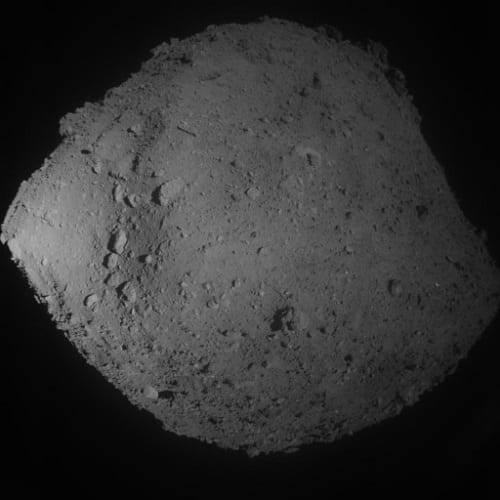Goodbye, Ryugu! It’s Been a Real Pleasure for the Hayabusa 2 Spacecraft, Now Returning Home
November 13, 2019
by Andreea Sterea
It sent rovers and landers on its surface. It shot a bullet at it. Then, it fired a cannonball at it. After a dramatic but loving relationship with asteroid Ryugu, Japan’s Hayabusa 2 spacecraft finally returns home today.
Japan’s space agency – JAXA – announced on Twitter earlier that the turbulent relationship of Hayabusa 2 spacecraft with its buddy asteroid Ryugu finally came to its end. Hayabusa 2 met Ryugu mid 2018 and, since then, they kept a close and relatively dramatic relationship.
Hyabusa 2 has been chasing Ryugu since 2014 to collect samples from this near-Earth asteroid shaped like a diamond. Earlier this summer, the spacecraft completed a second touch-down maneuver to collect even more samples from its surface. Now, it is time for this relationship to end. It seems that Hayabusa 2 took everything from Ryugu and now it leaves it all alone into the cold vastness of space. But this is how it works, it seems, and we are all excited for the spacecraft’s return.
We are finally leaving Ryugu! Departure is today (November 13) at 10:05 JST (onboard time). The RCS thrusters (chemical engines) are scheduled to begin moving us away from Ryugu at about 10cm/s.
— HAYABUSA2@JAXA (@haya2e_jaxa) November 12, 2019
Hyabusa 2 and Ryugu: A Budding Story We Loved to Watch Unfold
The original Hayabusa mission returned a sample of Itokawa asteroid back to Earth in 2010. The Hayabusa 2 was the sequel and a more ambitious one to boot.
Hayabusa 2 left for asteroid Ryuku in 2014 and has been chasing Ruygu ever since. It was a bumpy road, to say the least, as the spacecraft soon discovered that the asteroid’s surface was rockier than initially believed. To collect the samples they needed, JAXA began to court Ryugu with… unorthodox but efficient methods.
Besides successfully shooting a bullet at Ryugu and – for the first time in the history of space exploration – firing a cannon projectile onto its surface, it also masterfully deployed two Minerva robotic rovers to the surface of the asteroid.
All in the name of science, of course, and to make SCI FI movie directors green with envy. After all, if you shoot bullets and cannonballs at asteroids while sending spectacular images and videos back to Earth, you are worthy of at least an Oscar in our opinion.
The surface of Ryugu was not what we expected. So our sampler team had to conduct an experiment to check we could still gather material from the asteroid surface when we attempt #haya2_TD touchdown this Friday! https://t.co/bCzvW2gwSr pic.twitter.com/XxJXETKB6N
— HAYABUSA2@JAXA (@haya2e_jaxa) February 18, 2019
Hyabusa 2 Does not Come Empty Handed
Talking about separation in good terms, the two partners managed to exchange souvenirs. Ryugu gets to keep the bullet and some fragments of the cannonball, while Hyabusa 2 comes back home with enough samples to offer Japanese scientists a run for their money. They hope to analyze the samples and unravel even more mysteries about our solar system.
The homecoming party will be in late 2020, but we are sure the spacecraft will ace it, just as it will pass the departure process with flying colors. The touch-down was a high-risk endeavor, along with all that firing, the rovers’ deployment, and the unforeseeable events that might have occurred in space.
Despite all the challenges, the Hyabusa 2 is burdened with glorious purpose – teaching humankind a bit more about its neighborhood.
Rover-1B succeeded in shooting a movie on Ryugu’s surface! The movie has 15 frames captured on September 23, 2018 from 10:34 - 11:48 JST. Enjoy ‘standing’ on the surface of this asteroid! [6/6] pic.twitter.com/57avmjvdVa
— HAYABUSA2@JAXA (@haya2e_jaxa) September 27, 2018
What Does Hayabusa 2 Mean For Future Space Explorations?
Prior to the second touchdown mission, Hitoshi Kuninaka, director general of Japan’s Institute of Space and Astronautical Science (ISAS), said that
We would like to cover Mercury all the way to Jupiter. For the future missions, Hayabusa2 [and] the second touchdown will play a very important role. It’s a major pivotal point and a cornerstone.
Hayabusa 2 seems to be a little frivolous. According to JAXA, the spacecraft will fly past Earth and deliver the sample return capsule in December 2020. However, if it keeps enough fuel, it may go chase after another asteroid to sample its surface too. We wonder what Ryugu thinks of it.

Hayabusa 2 – A Success Story All the Way
We all have to admit that the story and quests of Hayabusa 2 kept all space lovers, stargazers, and science buffs glued to the edge of our seats. How many times did you hear about spacecrafts shooting at asteroids, outside the context of a SCI FI movie? The valiant ship and the crew behind it did a wonderful job at taking humankind to where it has never gone before. Now, all it has to do is make a spectacular (and safe) comeback.
Want more science now?
Check out our news page where we post interesting studies and discussions (sometimes mocking them mercilessly) for more.
